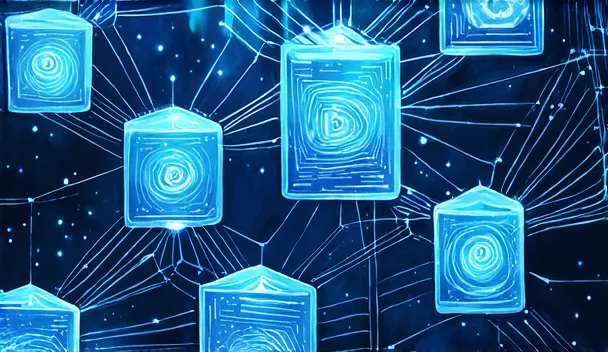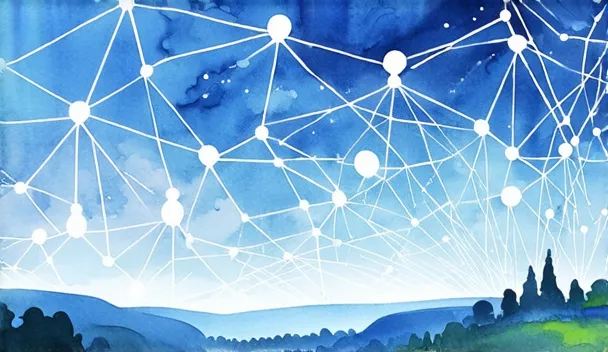What is Web3

The internet has undergone significant transformations since its inception, evolving from a read-only platform to an interactive and immersive experience. As we navigate this new era of digital innovation, a novel paradigm emerges - Web3, built on the principles of decentralization, blockchain technology, and peer-to-peer interactions.
This nascent ecosystem promises to redefine the way we interact with online platforms, empowering users and reducing reliance on centralized authorities. But what exactly is Web3, and how does it differ from its predecessors?
In this article, we will delve into the core principles of Web3, exploring its key characteristics, technological underpinnings, and real-world applications. We'll also examine the benefits and challenges associated with this emerging technology, providing a comprehensive understanding of what Web3 has to offer.
Defining Web3: The Future of the Decentralized Internet
Key Characteristics of Web3: Understanding the Decentralized Ecosystem
Web3 is characterized by several key features that set it apart from its predecessors. One of the primary characteristics is decentralization, which means that data and applications are stored and managed across a network of nodes rather than being controlled by a single central authority.
This decentralized ecosystem enables greater security, transparency, and interoperability between different systems and platforms. Another crucial aspect of Web3 is the use of blockchain technology, which provides an immutable and tamper-proof record-keeping mechanism.
Additionally, Web3 relies on token-based economics, allowing users to participate in the creation and governance of online communities through cryptocurrencies and non-fungible tokens (NFTs). Think of it as a democratized internet where users have more control over their own data and can participate in shaping the ecosystem.
Deciphering Decentralized Networks in Web3
In traditional web infrastructure, centralized networks rely on a single point of control to manage and verify data.
In contrast, decentralized networks in Web3 operate on a peer-to-peer basis, where multiple nodes interact with each other without the need for intermediaries.
This fundamental shift enables greater security, transparency, and scalability. Decentralized networks are akin to a swarm of birds flying together, where each bird's movement influences the collective trajectory, yet no single bird controls the entire flock.
Similarly, in Web3, decentralized networks facilitate seamless interactions among nodes, allowing data to be shared and verified without relying on centralized authorities.
The Role of Blockchain Technology in Driving the Web3 Movement
Blockchain technology plays a pivotal role in driving the Web3 movement by providing a decentralized, secure, and transparent infrastructure for online interactions.
By leveraging blockchain, Web3 applications can eliminate intermediaries and single points of control, enabling users to directly interact with one another without relying on centralized authorities. This is analogous to how BitTorrent revolutionized file sharing by decentralizing data storage and distribution.
Similarly, blockchain technology enables decentralized networks like Polkadot and Cosmos to interoperate, fostering a more open and interconnected Web3 ecosystem.
By harnessing the power of blockchain, Web3 applications can ensure that online transactions are trustworthy, verifiable, and resistant to censorship.
Core Principles of Web3: Empowering Users through Decentralization and Peer-to-Peer Interactions

Redefining Power Dynamics: How Web3 Empowers Individuals and Reduces Central Authority
Web3's decentralized architecture fundamentally shifts the power dynamics in favor of individuals, allowing them to regain control over their data, identity, and interactions.
Unlike traditional web applications, where a central authority dictates rules and monitors activity, Web3 enables peer-to-peer transactions and interactions without intermediaries.
This paradigm empowers users to make choices about how they share their personal information, interact with services, and participate in online communities. For instance, blockchain-based social media platforms can enable users to own and control their content, rather than relying on centralized entities that profit from user-generated data.
By reducing reliance on central authorities, Web3 fosters a more transparent and inclusive digital landscape.
Enabling Direct Communication Without Intermediaries
At its core, Web3 is about facilitating direct communication and interaction between individuals without relying on intermediaries.
This is achieved through blockchain technology, which allows for peer-to-peer (P2P) transactions to take place securely and efficiently.
Think of it like a phone call - in the traditional Web2 model, your call would go through a centralized server (the "intermediary") before reaching its final destination.
In contrast, Web3 enables direct connections between devices, much like how two people can communicate directly via walkie-talkies without needing a central hub.
Empowering Users in a Decentralized Digital Landscape
In contrast to Web2, where users are reliant on centralized platforms and intermediaries, Web3 empowers individuals by giving them control over their digital lives. This is achieved through the use of blockchain technology and peer-to-peer interactions, which enable direct connections between users without the need for intermediaries.
Think of it like a social media platform where you own your data and can share it directly with others, rather than relying on a company to host and manage it for you. In this way, Web3 provides a more democratic and inclusive digital landscape, allowing users to participate in online communities and transactions without sacrificing their autonomy or agency.
Blockchain Technology in Web3: A Deep Dive into Distributed Ledger Systems

Understanding the Technology Behind Web3: A Deep Dive into Distributed Ledgers
At its core, blockchain technology is a distributed ledger system that enables secure and transparent data management.
Imagine a digital accounting book where multiple parties can record transactions without relying on a single central authority. This decentralized approach allows for tamper-proof data storage and facilitates trust among users.
In Web3, this technology plays a pivotal role in facilitating peer-to-peer interactions, such as cryptocurrency transactions or smart contract executions.
Distributed ledgers ensure that all network participants have access to the same information, making it virtually impossible for any single entity to manipulate the data.
Decentralized Data Storage and Management Solutions
In Web3, blockchain technology enables decentralized data storage and management solutions, allowing users to store and manage their data without relying on centralized entities.
This is achieved through distributed ledger systems, where data is stored across a network of nodes rather than in a single location.
Think of it like a library where books are not stored in one central building, but instead, each book is distributed among various libraries across the city.
Each library has a copy of the same book, and if one library's book gets damaged or lost, it can be easily replaced by another library.
Similarly, blockchain technology ensures that data is redundantly stored and managed across a network, making it more secure, transparent, and resistant to censorship.
How Blockchain Enables Seamless Peer-to-Peer Interactions in Web3
Blockchain technology is the backbone of seamless peer-to-peer interactions in Web3, enabling secure and decentralized communication between users. By leveraging distributed ledger systems, blockchain allows for the creation of a transparent and tamper-proof network that facilitates trustless transactions.
Imagine a digital "handshake" where two parties can engage in a direct transaction without relying on intermediaries, much like how cash is exchanged in physical interactions.
In Web3, blockchain empowers users to interact directly with one another, eliminating the need for centralized authorities and enabling faster, more secure, and cost-effective transactions.
The Evolution of the Internet: From Web1 to Web3 - A Journey Through Time

The Read-Only Internet of the Past
The first generation of the internet, often referred to as Web 1.0, was a read-only platform where users could only consume information without contributing or interacting with it. This era was marked by static websites, online directories, and basic e-commerce platforms.
Think of it like a library where you can only browse through books on shelves, but not contribute to the content or interact with other readers. The internet was largely a one-way communication channel, where users had limited control over their digital experience.
This passive approach to the internet laid the groundwork for the next stage in its evolution - an era that would bring about significant changes in how we interact with and contribute to online content.
From Web 2.0 to Social Media: A Journey Through Centralization
The advent of Web 2.0 marked a significant shift in the way people interacted with the internet, as users began to create and share their own content on platforms like YouTube, Twitter, and Facebook.
However, this newfound freedom came at a cost - the rise of centralized authorities controlling what we see, interact with, and share online. Social media giants became gatekeepers, dictating what's acceptable and what's not, often prioritizing profit over user well-being.
This centralization has led to concerns around data ownership, censorship, and the spread of misinformation. As users, we're forced to trade our personal data for access to these platforms, creating an unbalanced power dynamic that Web3 aims to rectify by promoting decentralized networks and community-driven governance.
Decentralization and Blockchain Integration - The Rise of Web3
The advent of blockchain technology has given rise to a new era in internet evolution, aptly named Web3. This latest iteration is characterized by decentralization and the integration of blockchain principles.
Think of it as a vast, open network where data is stored not on centralized servers but across countless computers worldwide. In this setting, users regain control over their personal data, much like how decentralized currencies operate.
The beauty of this setup lies in its resilience to censorship and tampering - once data is recorded on the blockchain, it's there to stay, transparent and accessible for all to see.
Key Features and Benefits of Web3: Enhanced Privacy, Security, Scalability, and Interoperability

Enhancing User Privacy in Web3: Measures for a Secure Decentralized Ecosystem
In the realm of Web3, user privacy is paramount. Unlike traditional web applications that rely on centralized servers to store and manage data, decentralized ecosystems like blockchain networks prioritize anonymity and confidentiality.
To achieve this, Web3 employs several measures to safeguard user identities and transactions. Zero-knowledge proofs, for instance, enable users to authenticate their credentials without revealing sensitive information.
Similarly, homomorphic encryption allows computations to be performed directly on encrypted data, eliminating the need for intermediaries or data exposure.
These cutting-edge technologies empower users with greater control over their personal data, ensuring a more secure and private experience in the Web3 ecosystem.
Security Solutions for Decentralized Networks
Web3's decentralized architecture relies on a network of nodes to validate and store transactions, making it inherently more secure than traditional centralized systems.
One of the key security solutions is cryptography, which enables secure communication between nodes without relying on intermediaries. This is analogous to sending a secret message in an envelope: even if someone intercepts the envelope, they can't read the contents without knowing the decryption key.
Web3 also employs consensus algorithms, such as proof-of-stake (PoS) or proof-of-work (PoW), to ensure that nodes agree on the state of the network and prevent malicious actors from manipulating transactions.
Scalability and Interoperability Strategies for Seamless Interaction
Web3's scalability and interoperability features enable seamless interactions between different blockchain networks, applications, and users.
To achieve this, Web3 employs various strategies such as sharding, off-chain computing, and cross-chain bridges. These strategies allow Web3 applications to scale efficiently, interact with each other seamlessly, and provide users with a cohesive experience.
Sharding allows a single blockchain to be divided into smaller, more manageable pieces called shards, improving overall performance.
Off-chain computing enables complex computations to be performed outside of the main blockchain, reducing congestion and increasing scalability. Cross-chain bridges facilitate communication between different blockchains, much like how internet protocols enable data exchange between different networks.
Overcoming Challenges and Capitalizing on Opportunities in Web3 Adoption

Regulatory Frameworks for Decentralized Governance
The decentralized nature of Web3 poses significant challenges for regulatory frameworks. Traditional governance models rely on centralized authority, which contradicts the principles of blockchain technology.
To address this, new regulatory approaches are emerging that balance the need for oversight with the need for autonomy. For instance, "regulatory sandboxes" allow innovators to test new technologies and business models while collaborating with regulators to develop tailored guidelines.
Another approach is "co-regulation," where industry participants work together to establish common standards and best practices. These innovative frameworks can facilitate Web3 adoption by providing clarity and certainty for developers, investors, and users.
Addressing Scalability and Usability Concerns in Web3 Adoption
As Web3 technology continues to gain traction, it's crucial to address the scalability and usability concerns that have hindered its widespread adoption. Similar to how the internet transitioned from dial-up modems to high-speed fiber optic connections, blockchain networks must overcome their current limitations to support a growing user base.
This can be achieved by implementing sharding, off-chain transactions, or other second-layer scaling solutions. Additionally, developers are working on creating more user-friendly interfaces and applications that abstract away the complexities of blockchain technology, making it more accessible to non-technical users.
By solving these scalability and usability challenges, Web3 can unlock its full potential and become a seamless part of our daily lives.
Balancing Control and Security in a Decentralized Environment - A Delicate Balance
Web3's decentralized nature presents a paradox: how can we maintain control over our digital lives while ensuring security in the absence of central authority?
It's akin to trying to hold water in your hands - too much grip, and it spills; too little, and it slips away.
To find this balance, developers are employing innovative solutions such as decentralized governance models, where decision-making power is distributed among stakeholders, and multi-factor authentication systems that protect user data without relying on central control.
Another approach is to implement smart contracts with built-in security measures, which can self-execute and enforce rules without the need for intermediaries.
Real-World Applications and Use Cases of Web3 Technologies - Empowering a Decentralized Future

Empowering User Control through Blockchain-Based Solutions
Blockchain-based solutions are revolutionizing the way users interact with digital platforms, enabling them to regain control over their personal data and online experiences. By leveraging decentralized networks and cryptographic algorithms, these solutions provide a secure and transparent environment for users to manage their identities, assets, and interactions.
For instance, blockchain-based social media platforms allow users to own their content and decide how it's shared, much like how they manage physical possessions in the real world. Similarly, decentralized finance (DeFi) applications empower users to take control of their financial transactions, eliminating intermediaries and ensuring secure, peer-to-peer exchanges.
Blockchain-Based Supply Chain Management Systems for Efficiency
Imagine a supply chain where every step, from sourcing to delivery, is transparent and tamper-proof. Blockchain-based supply chain management systems are making this vision a reality.
By utilizing decentralized networks and cryptographic algorithms, these systems enable real-time tracking and verification of goods movement, reducing the risk of counterfeiting and errors.
Companies like Maersk and Walmart are already leveraging blockchain to streamline their logistics and inventory management, resulting in increased efficiency, reduced costs, and improved customer satisfaction.
For instance, a blockchain-based system can track a shipment of coffee beans from the farm to the consumer's cup, providing a transparent and verifiable record of origin, quality, and movement.
Peer-to-Peer Marketplaces and E-commerce Platforms - The Future of Commerce
The rise of Web3 technologies is revolutionizing the way we conduct commerce. Peer-to-peer marketplaces and e-commerce platforms are emerging as key players in this decentralized future.
By leveraging blockchain and cryptocurrency, these platforms enable direct transactions between buyers and sellers without intermediaries. This not only reduces transaction fees but also fosters a sense of community and trust among users.
For instance, platforms like OpenBazaar and Rarible allow creators to sell digital goods directly to consumers, eliminating the need for intermediaries like Amazon or eBay. Similarly, decentralized marketplaces like Uniswap enable token holders to trade assets in a trustless environment, eliminating the risk of centralized exchanges.
As Web3 technologies continue to evolve, we can expect to see more innovative applications that empower users and redefine the commerce landscape.
Conclusion
In this comprehensive exploration of Web3, we've delved into the defining principles and core technologies driving the decentralized internet. By understanding the evolution from Web1 to Web3, we can appreciate the empowering nature of blockchain technology in enabling peer-to-peer interactions and decentralizing power dynamics.
The benefits of Web3 are numerous, including enhanced user privacy, security, scalability, and interoperability. As we navigate real-world applications and use cases, it's clear that Web3 technologies have the potential to revolutionize industries and empower a decentralized future.
While challenges remain, embracing the opportunities presented by Web3 can lead to a more inclusive, secure, and transparent digital landscape. As we look to the future, one thing is certain - the adoption of Web3 will continue to shape the internet's trajectory, offering unparalleled possibilities for innovation and growth.